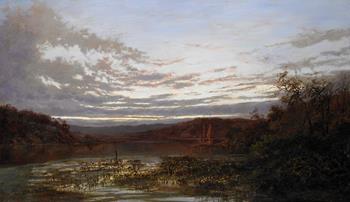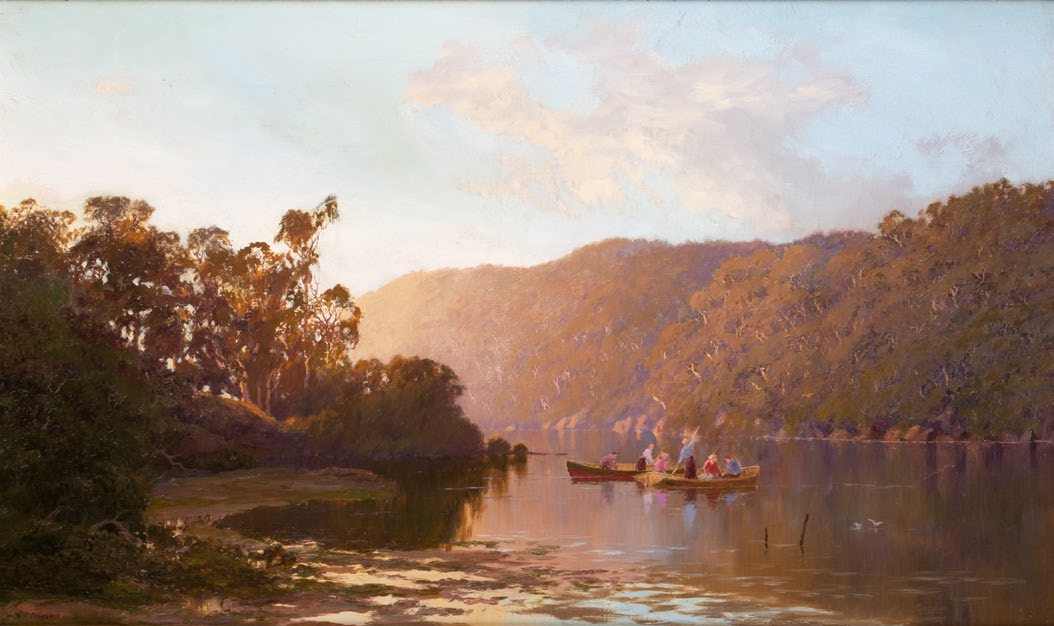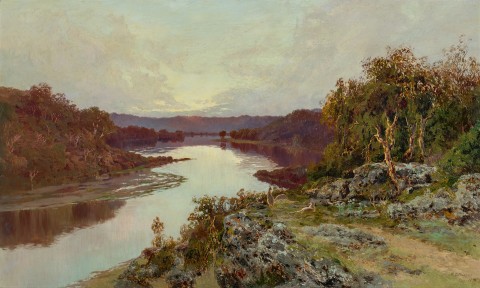“WHEN THE GLOW IS IN THE WEST”, LANE COVE FROM ABOVE THE BRIDGE, 1893
WILLIAM CHARLES PIGUENIT
oil on canvas
76.0 x 127.0 cm
signed and dated lower right: W.C. PIGUENIT/ 1893
James R Lawson, Sydney, 25 October 1911
Private collection
Christie’s, Sydney, 6 October 1976, lot 291 (as ‘A Coastal River, New South Wales’)
Lauraine Diggins Gallery, Melbourne
Danuta and Ted Rogowski, Melbourne
The Rogowski Collection, Leonard Joel, Melbourne, 23 February 1998, lot 43
The Cbus Collection of Australian Art, Melbourne, acquired from the above
Art Society of New South Wales 15th Exhibition, York Street, Sydney, September 1894, cat. 309
Selected Australian Works of Art, Lauraine Diggins Gallery, Melbourne, 24 October – 4 November 1983, cat. 17 (illus. in exhibition catalogue, as ‘A Coastal River, New South Wales’)
W.C. Piguenit, 1836 – 1914: retrospective, Tasmanian Museum and Art Gallery, Hobart, 16 December 1992 – 14 February 1993 and touring, Art Gallery of New South Wales, Sydney, 10 March – 2 April 1993; Art Gallery of Western Australia, Perth, 13 May – 4 July 1993, cat. 36 (label attached verso)
Dawn to Dusk: Landscapes from the Cbus Collection of Australian Art, Latrobe Regional Gallery, Victoria, 31 May – 16 November 2014
on long term loan to Geelong Art Gallery, Victoria
‘The Piguenit Exhibition’, Sydney Morning Herald, Sydney, 23 October 1911, p. 10 (as ‘When the Glow is in the West’)
Johannes, C., and Brown, A., W.C. Piguenit, 1836 – 1914: retrospective, Tasmanian Museum and Art Gallery, Hobart, 1992, cat. 36, pp. 58 (illus., as ‘Lane Cove from above the Bridge’), 65
Nainby, B., Stanhope, Z., and Furlonger, K., The Cbus Collection of Australian Art, in association with Latrobe Regional Gallery, Melbourne, 2009, pp. 14, 17, 28 (illus.), 230
WCPIGUENIT-Awintereve-Dd101370.jpg

‘I often look down the estuary of Lane Cove, near our house, and am struck with the blueness of the landscape. The trees, at a distance of only half a mile, are a rich purplish blue, set in a blue environment which gives a dreamy blue indefiniteness to the whole landscape, which is often intensified in the early mornings.’1
No matter how commanding the scenery beyond might be – often towering mountains or sweeping vistas – few of William Charles Piguenit’s landscapes fail to contain expanses of water: streams, rivers, lakes, even floodwaters, reflective of their surroundings, the atmospheric weather and the changing times of day. A favourite topic in the 1880s and 1890s were the waters, tidal mudflats, mangroves and gumtree-lined banks of Lane Cove River, Turrumburra to its Gamaragal owners, an estuary and tributary of the Parramatta River, north-west of Sydney’s centre. From 1882 until his death in 1914, Hobart-born Piguenit lived with his family in Hunters Hill, a short stroll from the river and its meandering flow became familiar both to him, and to his receptive audience.
Piguenit painted the river from a variety of locations, from Onions Point on the eastern tip of the peninsula, to Buffalo Creek and further upstream. However, his views of the river often centred around Fig Tree Bridge, near his house.2 An iron truss swing bridge completed in 1885, it was the first bridge to cross Lane Cove River, and one of a series of bridges that allowed road traffic to traverse from the south and north shores of Port Jackson. Thus, it also permitted Piguenit to explore the river’s banks on foot, and many of his paintings are titled in relation to this important structure – above, below, or near. In one view, he painted the bridge cutting across the river, a rare inclusion by Piguenit of the built environment and its impact upon the landscapes he so loved.3 More typically he incorporated gentle reminders of human presence: a rowing boat, or a larger sailing boat in the distance; figures on the riverbank; cattle or the occasional house. Sparsely inhabited until well into the twentieth century, the Lane Cove valley was nevertheless impacted, with early timber felling, and then noxious tanneries, dairies and orchards benefitting from its waters and proximity to Sydney’s markets.
DH2022 CBUS Cat (July) FA (With cover added) HR (individual).jpg

None of this is evident in this panoramic painting, Lane Cove from above the bridge, 1893.4 There is no sign of human activity and, unusually, Piguenit included a group of kangaroos, haloed by the last rays of the setting sun, as the only observers of this tranquil, almost mesmeric scene.5 One likes to think that Piguenit did indeed come across kangaroos still living in the bushland at that time.6 This painting is an exemplar of Piguenit’s peaceful river scenes, which also included the Derwent, Huon, Nepean and Murray. The luminous expanse of the water leads our eyes to the purple hills, while the light clouds similarly direct our attention to the horizon. The eucalypts on the opposite bank are in shadow, while the right bank catches the golden raking light, its proximity to the viewer enhanced by the details of the textured multi-coloured rocks, gnarled bark and the zigzags of the drooping branches. The original title of this painting may have been When the glow is in the west, exhibited the year after this was painted and about which a later reviewer wrote that ‘the exquisitely painted surface of the river that shines like a mirror will be especially admired’.7
Despite the high acclaim and numerous accolades with which Piguenit’s evocative landscapes were received during the latter nineteenth century, his subsequent reputation has been overshadowed by those of contemporaries such as Louis Buvelot and the young guns of the Australian Impressionists whose landscapes were pastoral rather than sublime. But Piguenit warrants ongoing recognition for his fascination with atmospheric effects (particularly light upon water) and his determination to reveal the grandeur of remote landscapes of Tasmania and New South Wales to an urban audience. Indeed, many of the regions he painted are tourist highlights today, such as Lake St Clair and Lake Pedder. Fortuitously much of the upper Lane Cove River has been protected from development and is now enjoyed by visitors to the Lane Cove National Park.
1. Piguenit to Legge, 1896, quoted in W.V. Legge, W.C. Piguenit: An Appreciation of a Tasmanian Artist, Passmore, Launceston, 1922, p. 8
2. Saintonge, 42 Avenue Road, Hunters Hill. Piguenit never married and lived with his parents, sisters and their husbands throughout his life. The current Figtree Bridge was built in 1963.
3. The Lane Cove River, undated, oil on canvas, sold Sotheby’s, Melbourne, 2 May 2000, lot. 54
4. Piguenit often titled his works ‘Lane Cove’ rather than ‘Lane Cover River’.
5. A trio of kangaroos was also included in his monochromatic oil painting The King William Range, Tasmania, 1891 (Tasmanian Museum and Art Gallery), but such wildfire is otherwise rare. See S. Backhouse, Brown, T. and Johannes, C., A Passion for Nature: William Charles Piguenit, Tasmanian Museum and Art Gallery, Hobart, 2012, illus. p. 94
6. In complete and awful contrast, in 1885 Piguenit discovered the decomposing body of a murdered woman while walking with his dog near Lane Cove Road. Australian Town and Country Journal, 17 January 1885, p. 13; see https://trove.nla.gov.au/newspaper/article/71022653 (accessed 12 June 2022)
7. ‘The Piguenit exhibition’, Sydney Morning Herald, 23 October 1911, p. 10; see https://trove.nla.gov.au/newspaper/article/15283292 (accessed 12 June 2022)
ALISA BUNBURY
